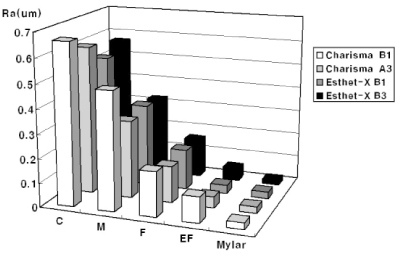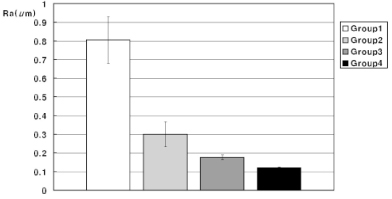References
1. Lui JL, Low T. The surface finish of the new microfill restorative materials. J Oral Rehabil 1982. 967–82.
2. van Noort R, Davis LG. The surface finish of composite resin restorative materials. Br Dent J 1984. 157360–364.
3. Toledano M, De La Torre FJ, Osorio R. Evaluation of two polishing methods for resin composites. Am J Dent 1994. 7328–330.
4. Weitman RT, Eames WB. Plaque accumulation on composite surfaces after various finishing procedures. J Am Dent Assoc 1975. 91101–106.
5. Strassler HE. Polishing composite resins. J Esthet Dent 1992. 4177–179.
6. Bollen CM, Lambrechts P, Quirynen M. Comparison of surface roughness of oral hard materials to the threshold surface roughness for bacterial plaque retention; a review of the literature. Dent Mater 1997. 13258–269.
7. Chan KC, Fuller JL, Hormati AA. The ability of foods to stain two composite resins. J Prosthet Dent 1980. 43542–545.
8. Moon AJ, Kwon HC. A study on the surface roughness and reflectivity after polishing of the microfill, hybrid composite resins. J Korean Acad Conserv Dent 1994. 19513–533.
9. Lee JY, Shin DH. Surface roughness of universal composites after polishing procedures. J Korean Acad Conserv Dent 2003. 28369–377.
10. Park SH, Noh BD, Ahn HJ, Kim HK. Celluloid strip-finished versus polished composite surface: ifference in surface discoloration on microhybrid composite. J Oral Rehabil 2004. 3162–66.
11. Wilson F, Heath JR, Watts DC. Finishing composite restorative materials. J Oral Rehabil 1990. 1779–87.
12. Hondrum SO, Fernandez R Jr. Contouring, finishing, and polishing class 5 restorative materials. Oper Dent 1997. 2230–36.
13. Chung KH. Effects of finishing and polishing procedures on the surface texture of resin composites. Dent Mater 1994. 10325–330.
14. Ozgünaltay G, Yazici AR, Gorucu J. Effect of finishing and polishing procedures on the surface roughness of new tooth-coloured restoratives. J Oral Rehabil 2003. 30218–224.
15. Roeder LB, Tate WH, Powers JM. Effect of finishing and polishing procedures on the surface roughness of packable composites. Oper Dent 2000. 25534–543.
16. Yap AU, Lye KW, Sau CW. Surface characteristics of tooth-colored restoratives polished utilizing different polishing systems. Oper Dent 1997. 22260–265.
17. Setcos JC, Tarim B, Suzuki S. Surface finish produced on resin composites by new polishing systems. Quintessence Int 1999. 30169–173.
18. Bouvier D, Duprez JP, Lissac M. Comparative eveluation of polishing systems on the surface of three aesthetic materials. J Oral Rehabil 1997. 24888–894.
19. Yap AUJ, Sau CW, Lye KW. Effect of finishing/polishing time on the surface characteristics of tooth-coloured restoratives. J Oral Rehabil 1998. 25456–461.
20. Nagem Filho H, D'Azevedo MTFS, Nagem HD, Marsola FP. Surface roughness of composite resins after finishing and polishing. Braz Dent J 2003. 1437–41.
21. Reis AF, Giannini M, Lovadino JR, Ambrosano GM. Effect of various finishing systems on the surface roughness and staining susceptibility of packable resins. Dent Mater 2003. 1912–18.
22. Hachiya Y, Iwaku M, Hosoda H, Fusayama T. Relation of finish to discoloration of composite resins. J Prosthet Dent 1984. 52811–814.
23. Okazaki M, Douglas WH. Comparison of surface layer properties of composite resins by ESCA, SEM, and X-ray diffractometry. Biomaterials 1984. 5284–288.
24. Carlén A, Nikdel K, Wennerberg A, Holmberg K, Olsson J. Surface characteristics and in vitro biofilm formation on glass ionomer and composite resin. Biomaterials 2001. 22481–487.
25. Dodge WW, Dale RA, Cooley RL, Duke ES. Comparison of wet and dry finishing of resin composites with aluminum oxide discs. Dent Mater 1991. 718–20.
26. Fruits TJ, Miranda FJ, Coury TL. Effect of equivalent abrasive grit sizes utilizing differing polishing motions on selected restorative materials. Quintessence Int 1996. 27279–285.
27. Tate WH, Powers JM. Surface roughness of composites and hybrid ionomers. Oper Dent 1996. 2153–58.
28. St Germain HA Jr, Meiers JC. Surface roughness of light-activated glass-ionomer cement restorative materials after finishing. Oper Dent 1996. 21103–109.
29. Pedrini D, Candido MSM, Rodrigues AL Jr. Analysis of surface roughness of glass-ionomer cements and compomer. J Oral Rehabil 2003. 30714–719.
30. Wilder AD Jr, Swift EJ Jr, May KN Jr, Thompson JY, McDougal RA. Effect of finishing technique on the microleakage and surface texture of resin-modified glass ionomer restorative materials. J Dent 2000. 28367–373.
31. Yap AU, Wong ML, Lim ACY. The effect of polishing systems on microleakage of tooth-coloured restoratives. Part 2: composite and polyacid-modified composite resinscomposite and polyacid-modified composite resins. J Oral Rehabil 2000. 27205–210.
32. Bertrand MF, Leforestier E, Muller M, Pegurier LL, Bolla M. Effect of surface penetrating sealant on surface texture and microhardness of composite resins. J Biomed Mater Res 2000. 53658–663.
33. Ferracane JL, Condon JR, Nitchem JC. Evaluation of subsurface defects created during the finishing of composites. J Dent Res 1992. 711628–1632.
34. Cho LR, Yi YJ, Heo SJ. Effect of tooth brushing and thermal cycling on a surface change of ceromers finished with different methods. J Oral Rehabil 2002. 29816–822.
35. O'Brien WJ, Johnston WM, Fanian F, Lambert S. The surface roughness and gloss of composites. J Dent Res 1984. 63685–688.
36. Campbell PM, Johnston WM, O'Brien WJ. Light scattering and gloss of an experimental quartz-filled composite. J Dent Res 1986. 65892–894.
37. Albers HF. Tooth-colored restoratives 1996. 8th edth ed. Santa Rosa, CA: Alto books; 101–10.
22.
38. Grajower R, Revah A, Sorin S. Reflectance spectra of natural and acrylic resin teeth. J Prosthet Dent 1976. 36570–579.
39. Seghi RR, Hewlett ER, Kim J. Visual and instrumental colorimetric assessments of small color differences on translucent dental porcelain. J Dent Res 1989. 681760–1764.
40. Report of Councils and Bureaus. New American Dental Association Specification No. 27 for direct filling resins. J Am Dent Assoc 1977. 941191–1194.
41. Hwang IN, Lee KW. Translucency of light cured composite resins depends on thickness & its influence on color of restorations. J Korean Acad Conserv Dent 1999. 24604–613.














